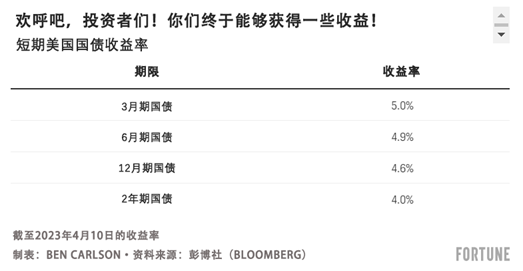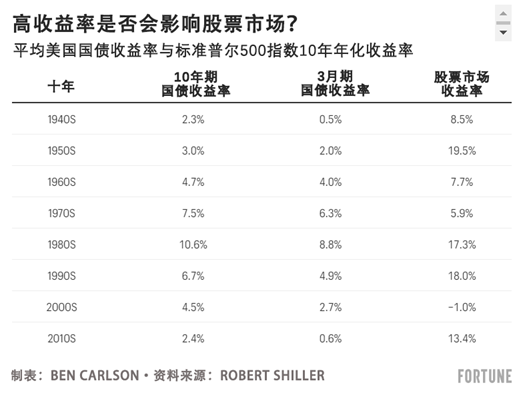
在2010年代大多數(shù)時間,,金融市場都處在一種別無選擇的大環(huán)境當中。在那個十年的大多數(shù)時間,,美聯(lián)儲(Federal Reserve)的短期利率都接近于0%,,與之前50年至60年相比,債券收益率微乎其微,。
股市的堅挺主要歸因于,,投資者認為除了股票以外沒有其他投資選擇。當固定收益投資產(chǎn)品和現(xiàn)金投資收益率較低時,,投資者為了賺取更高回報,,不得不承擔更大風險。
為了應對40年來最高的通脹率,,美聯(lián)儲開啟史上最激進的加息周期之一,,之后別無選擇的現(xiàn)象便不復存在。現(xiàn)在投資者有許多替代選擇,,而且這些選擇相對安全,。你可以投資收益率在4%至5%之間的貨幣市場基金、大額存單,、儲蓄債券,、在線儲蓄賬戶和老套的美國短期國債。
只要看看美國短期國債的收益率即可:

對于希望獲得更高收益率的投資者,,或者希望投資現(xiàn)金或部分更穩(wěn)定投資組合的人而言,,這是一種積極的變化。顯然,,通脹依舊居高不下,,因此實際收益率沒有名義收益率水平那么誘人,但鑒于過去十多年的低收益率,,我認為許多退休人士或固定收益產(chǎn)品投資者并不在乎,。
現(xiàn)在,股票市場的投資者需要回答這個問題:相對安全的美國國債更高的收益率,,是否意味著股票收益率下降,?
這種猜測在理論上是合理的。無風險收益率越高,意味著更低的估值,,可承受風險的更高門檻收益率以及更低的預期股票收益率,。
但金融市場理論往往不適用于現(xiàn)實世界里的金融市場。
例如,,在金融市場,,股票市場在更低利率時依舊表現(xiàn)糟糕的情況并不鮮見。有時候利率升高,,但股票市場卻表現(xiàn)穩(wěn)健,。
我研究了平均10年期美國國債收益率、平均3月期國債收益率和標準普爾500指數(shù)(S&P 500)10年年收益率,,以確定利率和股票市場的收益率之間是否存在任何關(guān)系,。

最高平均收益率發(fā)生在20世紀80年代,當時也是股票市場表現(xiàn)最好的十年之一,。在20世紀70年代和90年代,,股票收益率同樣較高,但其中一個十年期間,,股票市場收益率低于平均水平,,另外一個十年期間,股票市場的表現(xiàn)卻高于平均水平,。
2000年代,,國債收益率接近于平均水平,但股票市場卻表現(xiàn)糟糕,。
我認為有其他變量可以更好地解釋這些結(jié)果,,包括通貨膨脹、估值起點,、經(jīng)濟表現(xiàn)和利率方向等,。因此根據(jù)利率等任何一個變量,很難就收益率對市場的影響得出確切結(jié)論,。
大環(huán)境通常比任何一個變量的水平更重要,。
我還研究了當3月期國債全年平均收益率為5%時股票市場的表現(xiàn)。在過去89年,,這種情況共出現(xiàn)過25次,。在出現(xiàn)這種情況的25年中,標準普爾500指數(shù)的年化收益率為11%,。當無風險收益率高于平均水平時,股票市場的收益率也在平均水平以上,。
這并不能夠保證股票市場在更高利率環(huán)境下的表現(xiàn)較好,。或許這一次,,投資者可以接受5%的收益率,,暫時離開股票市場,。但歷史證明,當現(xiàn)金收益率更高時,,股票市場不一定表現(xiàn)較差,。
重要的是,股票是長期資產(chǎn),,而國債是短期資產(chǎn),。股票可能在短期內(nèi)波動,無風險收益率同樣如此,。
對投資者而言,,好消息是經(jīng)濟熱度超出預期,為我們提供了多年來最高的無風險收益率,。矛盾在于,,為了控制高于平均水平的通貨膨脹,經(jīng)濟需要降溫,。而無風險收益率也可能隨之下降,。
要抓住高國債收益率帶來的機會,但如果美聯(lián)儲的愿望實現(xiàn),,并且經(jīng)濟增速下降,,不要期待高收益率會一直持續(xù)下去。(財富中文網(wǎng))
本文作者的個人投資組合或里薩茲財富管理公司(Ritholtz Wealth Management)管理的投資組合中可能目前持有,、一直持有或未來持有本文提及的個別證券,。
翻譯:劉進龍
審校:汪皓
在2010年代大多數(shù)時間,金融市場都處在一種別無選擇的大環(huán)境當中,。在那個十年的大多數(shù)時間,,美聯(lián)儲(Federal Reserve)的短期利率都接近于0%,與之前50年至60年相比,,債券收益率微乎其微,。
股市的堅挺主要歸因于,投資者認為除了股票以外沒有其他投資選擇,。當固定收益投資產(chǎn)品和現(xiàn)金投資收益率較低時,,投資者為了賺取更高回報,不得不承擔更大風險,。
為了應對40年來最高的通脹率,,美聯(lián)儲開啟史上最激進的加息周期之一,之后別無選擇的現(xiàn)象便不復存在?,F(xiàn)在投資者有許多替代選擇,,而且這些選擇相對安全。你可以投資收益率在4%至5%之間的貨幣市場基金,、大額存單,、儲蓄債券、在線儲蓄賬戶和老套的美國短期國債,。
只要看看美國短期國債的收益率即可:
對于希望獲得更高收益率的投資者,或者希望投資現(xiàn)金或部分更穩(wěn)定投資組合的人而言,,這是一種積極的變化。顯然,,通脹依舊居高不下,因此實際收益率沒有名義收益率水平那么誘人,,但鑒于過去十多年的低收益率,我認為許多退休人士或固定收益產(chǎn)品投資者并不在乎,。
現(xiàn)在,,股票市場的投資者需要回答這個問題:相對安全的美國國債更高的收益率,是否意味著股票收益率下降,?
這種猜測在理論上是合理的,。無風險收益率越高,意味著更低的估值,,可承受風險的更高門檻收益率以及更低的預期股票收益率,。
但金融市場理論往往不適用于現(xiàn)實世界里的金融市場,。
例如,在金融市場,,股票市場在更低利率時依舊表現(xiàn)糟糕的情況并不鮮見,。有時候利率升高,,但股票市場卻表現(xiàn)穩(wěn)健,。
我研究了平均10年期美國國債收益率,、平均3月期國債收益率和標準普爾500指數(shù)(S&P 500)10年年收益率,以確定利率和股票市場的收益率之間是否存在任何關(guān)系,。
最高平均收益率發(fā)生在20世紀80年代,,當時也是股票市場表現(xiàn)最好的十年之一。在20世紀70年代和90年代,,股票收益率同樣較高,,但其中一個十年期間,股票市場收益率低于平均水平,,另外一個十年期間,,股票市場的表現(xiàn)卻高于平均水平。
2000年代,,國債收益率接近于平均水平,,但股票市場卻表現(xiàn)糟糕。
我認為有其他變量可以更好地解釋這些結(jié)果,,包括通貨膨脹,、估值起點、經(jīng)濟表現(xiàn)和利率方向等,。因此根據(jù)利率等任何一個變量,,很難就收益率對市場的影響得出確切結(jié)論。
大環(huán)境通常比任何一個變量的水平更重要,。
我還研究了當3月期國債全年平均收益率為5%時股票市場的表現(xiàn),。在過去89年,這種情況共出現(xiàn)過25次,。在出現(xiàn)這種情況的25年中,,標準普爾500指數(shù)的年化收益率為11%。當無風險收益率高于平均水平時,,股票市場的收益率也在平均水平以上,。
這并不能夠保證股票市場在更高利率環(huán)境下的表現(xiàn)較好?;蛟S這一次,,投資者可以接受5%的收益率,暫時離開股票市場,。但歷史證明,,當現(xiàn)金收益率更高時,股票市場不一定表現(xiàn)較差,。
重要的是,,股票是長期資產(chǎn),,而國債是短期資產(chǎn)。股票可能在短期內(nèi)波動,,無風險收益率同樣如此,。
對投資者而言,好消息是經(jīng)濟熱度超出預期,,為我們提供了多年來最高的無風險收益率,。矛盾在于,為了控制高于平均水平的通貨膨脹,,經(jīng)濟需要降溫,。而無風險收益率也可能隨之下降。
要抓住高國債收益率帶來的機會,,但如果美聯(lián)儲的愿望實現(xiàn),,并且經(jīng)濟增速下降,不要期待高收益率會一直持續(xù)下去,。(財富中文網(wǎng))
本文作者的個人投資組合或里薩茲財富管理公司(Ritholtz Wealth Management)管理的投資組合中可能目前持有,、一直持有或未來持有本文提及的個別證券。
翻譯:劉進龍
審校:汪皓
Throughout much of the 2010s, the financial markets were in a TINA (there is no alternative) environment. The Federal Reserve held short-term interest rates near 0% for much of the decade, and bond yields were paltry compared with the previous 50 to 60 years.
Much of the strength in the stock market was attributed to the idea that there simply was no investment alternative outside of equities. When fixed income and cash yields are so low, investors are forced to move further and further out on the risk curve to earn higher returns.
After the Fed went on one of the most aggressive interest rate hiking cycles in history to combat the highest inflation rates in 40 years, TINA is no longer. There are now plenty of alternatives for investors, and they are relatively safe choices. You can now find yields in the 4% to 5% range on money-market funds, CDs, savings bonds, online savings accounts, and boring old Treasury bills.
Just look at the yields on short-term U.S. government Treasuries:
This is a welcome development for those in search of higher yield for their cash or more stable parts of their portfolio. Obviously, inflation remains elevated so the real yields aren’t nearly as juicy as the nominal levels, but I’m not sure many retirees or fixed-income investors care considering how low yields were for the past decade-plus.
Now, the question for investors in the stock market is this: Do higher yields on relatively safe U.S. government debt securities mean lower returns for equities?
This makes sense in theory. A higher risk-free rate should mean lower valuations, a higher hurdle rate to accept risk and lower expected returns for stocks.
But financial market theory doesn’t always translate into the real world when it comes to the financial markets.
For example, there have been plenty of stretches in the financial markets where the stock market performed horribly even with the benefit of lower interest rates. And there have been times when rates were high, but the stock market did just fine for itself.
I looked at the average 10-year U.S. Treasury yields, the average three-month T-bill yields, and the S&P 500 annual returns by decade to see if there was any relationship between rates and stock market returns.
The highest average yields occurred in the 1980s, which was also one of the best decades ever for stocks. Yields were similarly elevated in the 1970s and 1990s, but one of those decades experienced subpar returns while the other saw lights-out performance.
Yield levels were more or less average in the 2000s, but the stock market performed terribly.
There are other variables I could have included here that would better explain these results—inflation, starting valuations, the performance of the economy, the direction of rates, etc. This is why it’s so difficult to look at a single variable such as rates to draw concrete conclusions about the impact on markets.
Context is often more important than the level of any one variable.
I also looked at the performance of the stock market when three-month T-bill yields averaged 5% for the entirety of a year. That’s been the case in 25 of the last 89 years. The annualized return for the S&P 500 in those 25 years was 11%. So in years with above-average risk-free rates, the stock market has actually seen above-average returns.
I’m not saying stocks are guaranteed to do well in a higher-rate environment. Maybe investors will be content with 5% yields this time around and lay off the stock market for a while. But history shows they’re not guaranteed to do poorly simply because cash is offering higher yields.
It’s important to remember that stocks are long-duration assets while T-bills are not. Just as stocks can fluctuate in the short run so, too, can the risk-free rate.
The good news for investors is a hotter-than-expected economy is now offering better risk-free rates than we’ve seen in years. The paradox here is it could require a slowdown in the economy to vanquish higher-than-average inflation. If that happens, risk-free rates are likely to fall as well.
Enjoy the high yields, but don’t expect them to last forever if the Fed gets its wish and slows down the economy.
Certain securities mentioned in this article may be currently held, have been held, or be held in future in the author’s personal portfolio or a portfolio managed by Ritholtz Wealth Management.






